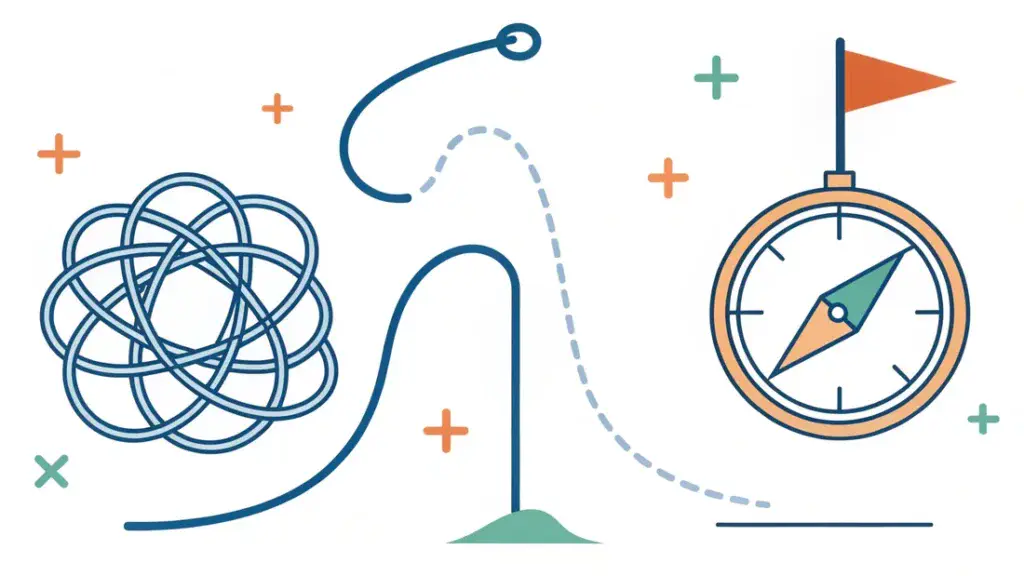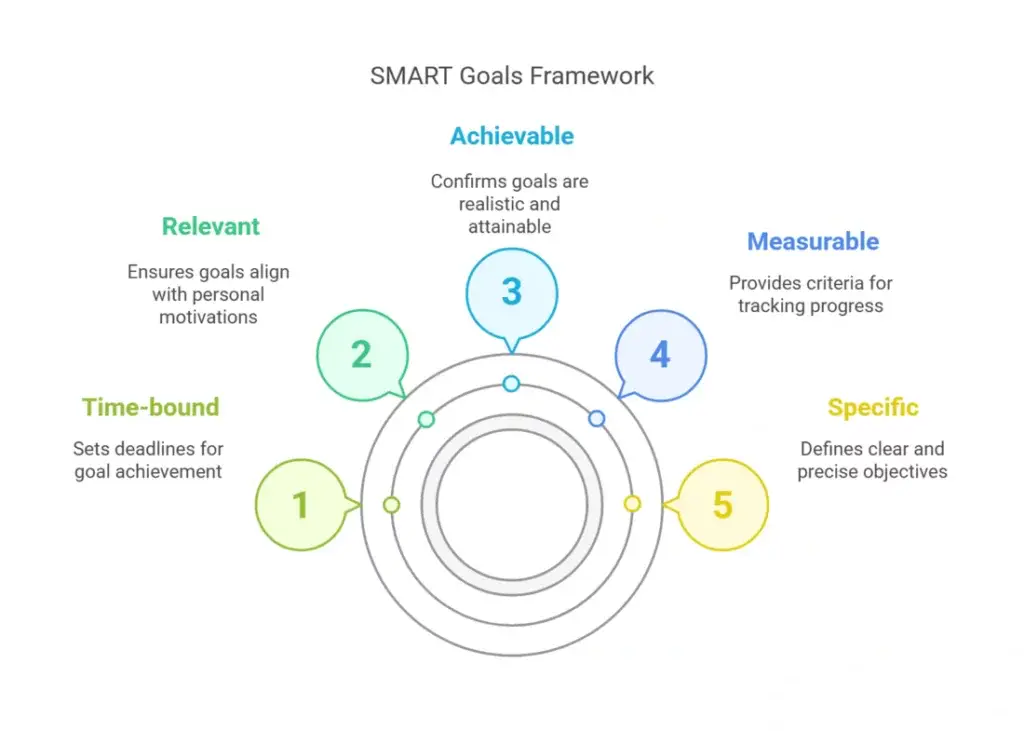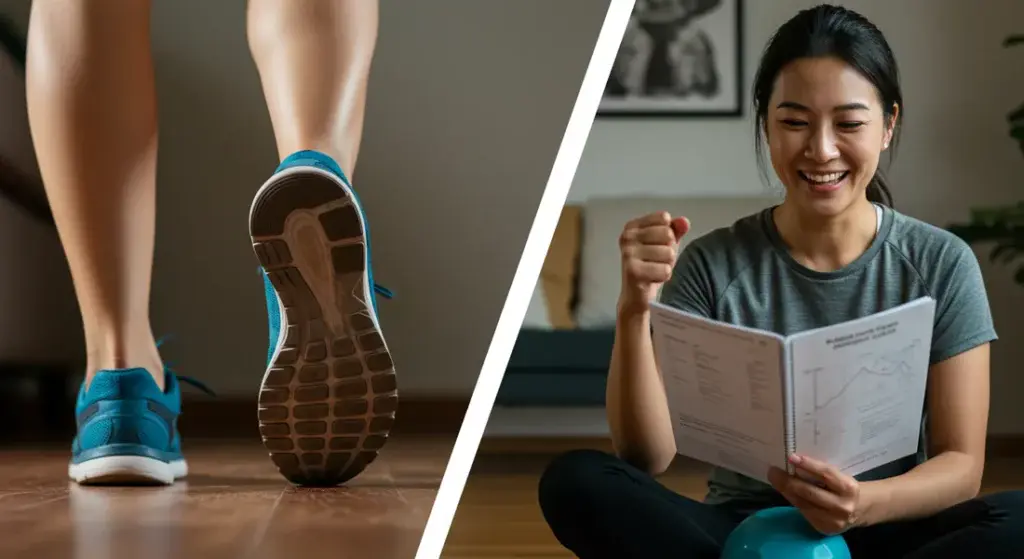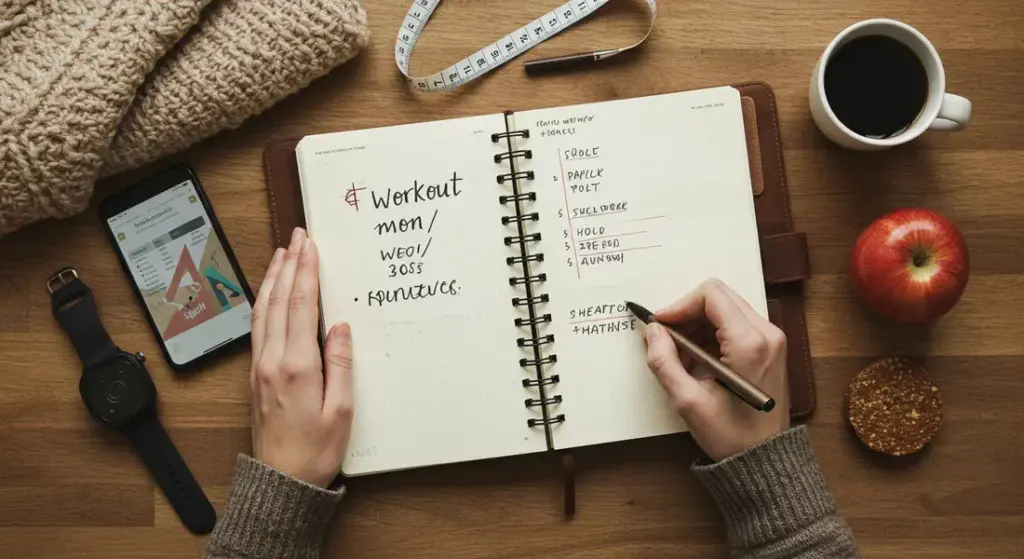You’re excited to start your home fitness journey – that energy is fantastic!
But pure enthusiasm, while essential, isn’t quite enough for long-term success.

Imagine setting off on a road trip with no map or destination; you might enjoy the initial drive, but you’ll likely end up lost or frustrated.
Fitness is similar. Without clear goals, your efforts can feel directionless, making it hard to stay motivated or even know if you’re making progress.
This guide is your roadmap.
We’re going to ditch vague wishes like “get fit” and teach you exactly how to set effective, realistic fitness goals that act as powerful fuel for your workouts.
Setting the right kind of goals prevents early discouragement and builds unstoppable momentum.
As a crucial step in our Beginners Guide to Starting Home Fitness – Your First Steps, defining your targets is fundamental.
It builds upon understanding the Why Start Working Out at Home? by giving your efforts purpose.
Plus, clear goals will directly inform your Creating a Beginner-Friendly Workout Schedule and significantly boost your ability for Staying Motivated When Working Out Alone.
Let’s build your personal fitness map!
Why Bother Setting Goals? The Power of Purpose
Spending a few minutes defining goals might seem like extra work, but the payoff is immense:
Beyond Vague Wishes – Goals Provide Direction
A clear goal acts like a compass, guiding your choices and efforts. Instead of randomly doing exercises, you’ll know why you’re doing them and what you’re working towards.
Fueling Motivation – Having Something to Aim For
Let’s face it, some days finding the energy to exercise is tough.
Having a specific goal you’re striving for gives your workouts meaning and makes it easier to push through when motivation dips.
It transforms exercise from a chore into a purposeful activity.
Measuring Success – Knowing You’re Making Progress
How do you know if your efforts are paying off?
Goals provide tangible benchmarks. Achieving them, even small ones, delivers a powerful sense of accomplishment and proves you’re moving forward.
The Common Pitfall – Vague Goals Lead to Vague Results

Have you ever set goals like these?
- “I want to get fitter.”
- “My goal is to lose some weight.”
- “I need to tone up.”
While the intention is good, these goals often fail because they are inherently vague.
What does “fitter” actually look like for you? How much weight is “some”? How will you objectively measure “toned up”?
These types of goals lack:
- Specificity: They don’t define the target clearly.
- Measurability: There’s no way to track progress objectively.
- Timeframe: There’s no deadline, reducing urgency.
Without clear parameters, it’s easy to feel like you’re not getting anywhere, leading to frustration and giving up.
We need a better system!
Introducing SMART Goals – Your Framework for Success
Enter the SMART goal framework – a simple yet incredibly powerful tool used in everything from business to personal development, and it’s perfect for fitness beginners.
SMART stands for:

S – Specific – What EXACTLY Do You Want to Achieve?
Be crystal clear. Vague won’t cut it.
- Instead of: “Exercise more.”
- Try: “Complete 3 home workouts of at least 20 minutes each, this week.“
- Instead of: “Get stronger legs.”
- Try: “Be able to perform 12 bodyweight squats with good form in a single set.“
M – Measurable – How Will You Track Progress?
You need numbers to know if you’re succeeding. How will you measure your goal?
- Instead of: “Improve endurance.”
- Try: “Walk continuously on my treadmill for 25 minutes without stopping (increase from 20 minutes).“
- Instead of: “Do push-ups.”
- Try: “Perform 5 full push-ups (or knee push-ups) with proper form by the end of the month.“
- Measurement examples: Number of workouts, duration, distance, reps/sets completed, weight lifted (if applicable), time holding a position (like a plank).
A – Achievable (or Attainable) – Is It Realistic For YOU Right Now?
This is CRITICAL for beginners. Aiming too high too soon is a recipe for burnout and disappointment.
Start where you are and build gradually.
- Instead of: “Run a 10k next month (having never run before).”
- Try: “Follow a beginner walk/jog program 3 times per week for the next 4 weeks.“
- Consider your current fitness level, how much time you realistically have, potential physical limitations, and the Essential vs. Nice-to-Have Home Fitness Gear you have access to. Start small, achieve it, build confidence, then aim higher.
R – Relevant – Does This Goal Matter to YOU?
Why did you decide to start home fitness in the first place?
More energy to play with kids? Better cardiovascular health? Stress management? Feeling stronger in daily life?
- Ensure your specific goals align with your deeper motivations. If your ‘why’ is stress relief, a goal focused purely on lifting heavier weights might not be as relevant as one focused on completing calming yoga routines consistently.
T – Time-bound – When Will You Achieve It By?
Setting a deadline creates a sense of urgency and provides clear milestones for evaluation.
- Instead of: “Learn to hold a plank longer someday.”
- Try: “Be able to hold a proper plank for 45 seconds by the end of this month.“
- Set target dates for your goals – whether it’s the end of the week, month, or several months down the line.
Process Goals vs. Outcome Goals – The Beginner’s Secret Weapon
Understanding this distinction is game-changing:

Understanding the Difference
- Outcome Goals: These focus on the final result or achievement (e.g., lose 15 pounds, run a sub-30 minute 5k, fit into old jeans). While motivating, you don’t always have direct, daily control over these outcomes (weight fluctuates, race day conditions vary).
- Process Goals: These focus on the actions, behaviors, and habits required to reach the outcome goal (e.g., complete 4 planned workouts this week, pack a healthy lunch every workday, follow my stretching routine after each workout, drink 2 liters of water daily). You have direct control over completing these actions.
Why Prioritize Process Goals as a Beginner?
Focusing heavily on process goals is incredibly beneficial when starting out:
- Builds Consistency: It shifts focus to showing up and doing the work, which is the foundation of habit formation.
- Provides Frequent Wins: You control whether you do the workout or pack the lunch. Achieving these daily/weekly process goals builds confidence and momentum, even if the scale hasn’t moved much yet.
- Reduces Discouragement: Outcome results (like weight loss or strength gains) can take time. Focusing only on outcomes can be demoralizing if progress feels slow. Process goals keep you engaged with what you can control today.
- Leads to the Outcome: Consistently hitting your process goals is precisely what leads to achieving the desired outcome over time!
Focus on nailing your process goals, and the outcome goals will eventually take care of themselves.
Short-Term Sprints & Long-Term Vision
Effective goal setting uses both short and long horizons:
- Short-Term Goals (Weekly/Monthly): These are your immediate targets. They keep you focused day-to-day, provide quick feedback, and build momentum. Think of them as stepping stones.
- Example: “This week, I will complete three 25-minute bodyweight workouts from my beginner plan.”
- Example: “This month, I will try one new healthy recipe each week.”
- Long-Term Goals (3-6+ Months): These provide the bigger picture, the overarching direction. They keep the ‘why’ in focus.
- Example: “In 6 months, I want to be able to hike the ‘Blue Lake Trail’ without feeling exhausted.”
- Example: “By the end of the year, I aim to consistently exercise 3-4 times per week without feeling like it’s a chore.”
Your short-term goals should logically lead you towards achieving your long-term vision.
Putting It All Together – Writing Your First Goals
Ready to try? Here’s a simple process:
- Brainstorm Your ‘Why’: Briefly jot down why you started home fitness. What are your general hopes? (More energy, less stress, better health markers, strength for daily tasks?)
- Prioritize: Choose just 1 or 2 main areas to focus on initially. Don’t try to change everything at once!
- Draft using SMART: Turn your general hopes into specific, measurable, achievable, relevant, and time-bound goals.
- Focus on Process: Ensure you have at least 1-2 clear process goals (actions!) for the upcoming week. What specific actions will you take?
- Write Them Down! This simple act makes them feel more real and committed. Put them somewhere visible – on your fridge, bathroom mirror, phone lock screen, or in a workout journal.
Don’t Be Afraid to Track & Adjust

Setting goals is step one; monitoring them is step two.
How will you know if you’re hitting those ‘Measurable’ targets if you don’t track? (We’ll cover this more in a future guide on ➡️ Planned Tracking Progress guide).
Most importantly, be flexible! Life happens.
Sometimes you get sick, work gets crazy, or you realize a goal was slightly too ambitious. That’s okay!
Adjust your goals as needed rather than abandoning them entirely.
Regularly reviewing and tweaking your goals is a normal part of the process and key to Staying Motivated When Working Out Alone.
SMART Goal Setting for Fitness Success:
- Purpose is Power: Goals provide direction, motivation, and measure success.
- Ditch the Vague: Use the SMART framework for clarity:
- Specific (What?)
- Measurable (How much/many?)
- Achievable (Realistic for you?)
- Relevant (Aligns with your ‘why’?)
- Time-bound (By when?)
- Prioritize Process: Focus on controllable actions (Process Goals) to build habits and confidence.
- Use Both Horizons: Set Short-Term (weekly/monthly) and Long-Term (3-6+ months) goals.
- Write & Review: Put goals on paper, track progress, and adjust flexibly.
Conclusion – Your Actionable Fitness Plan Starts Now
Setting goals might seem like a small step, but it’s the difference between wandering aimlessly and purposefully navigating your fitness journey.
By using the SMART framework and prioritizing process goals, you’ve just equipped yourself with a powerful tool to transform vague intentions into an actionable, achievable plan.
You now have the knowledge to create meaningful targets that resonate with your reasons for starting home fitness.
Don’t just read this – take 10 minutes right now to draft your first 1-2 SMART process goals for the upcoming week. What specific actions will you commit to?
With your initial goals taking shape, you’re ready to think about structuring your time and ensuring you have what you need.
Head back to the main Beginners Guide to Starting Home Fitness and explore these essential next steps:
You’re building the foundation for lasting success – keep going!
References & Further Reading
Note: This information is for general knowledge and informational purposes only, and does not constitute medical advice. Always consult with a qualified healthcare professional before beginning any new fitness program or making any changes to your healthcare routine.
- Stewart, V., McMillan, S. S., Hu, J., Collins, J. C., El-Den, S., O’Reilly, C. L., & Wheeler, A. J. (2024). Are SMART goals fit-for-purpose? Goal planning with mental health service-users in Australian community pharmacies. International journal for quality in health care : journal of the International Society for Quality in Health Care, 36(1), mzae009. https://doi.org/10.1093/intqhc/mzae009
- Bailey R. R. (2017). Goal Setting and Action Planning for Health Behavior Change. American journal of lifestyle medicine, 13(6), 615–618. https://doi.org/10.1177/1559827617729634
